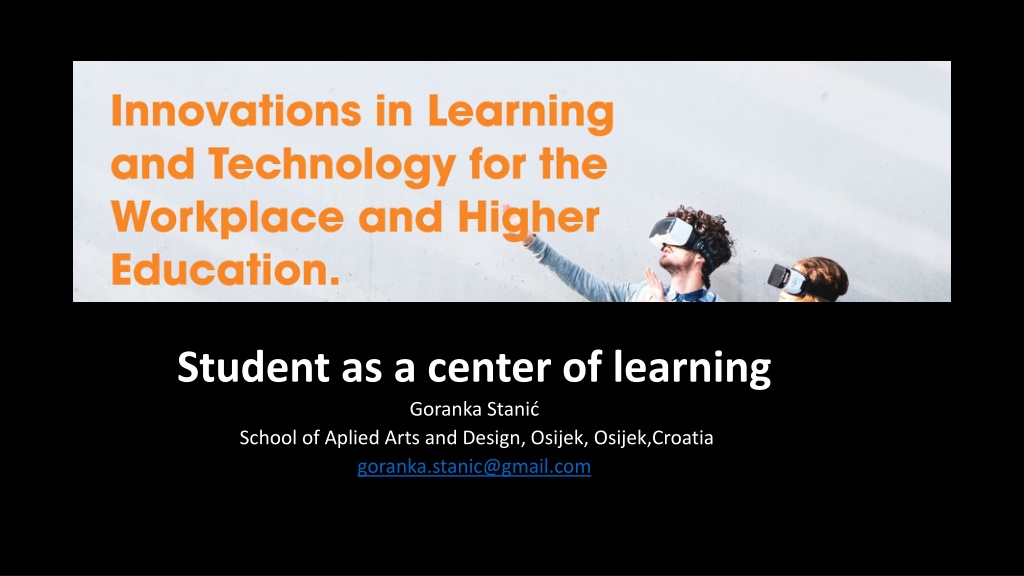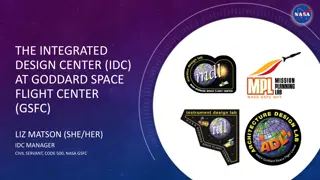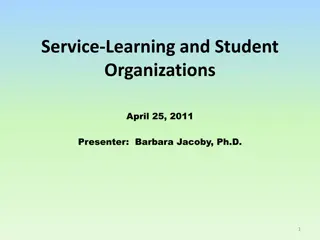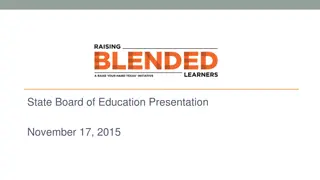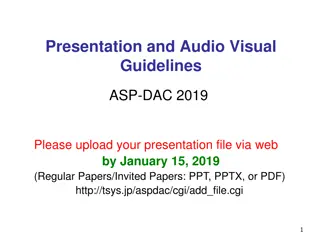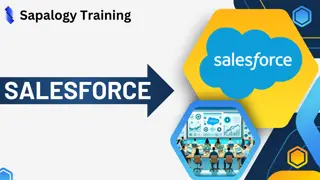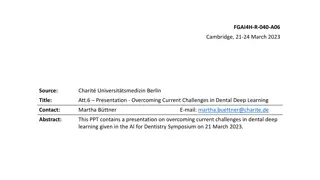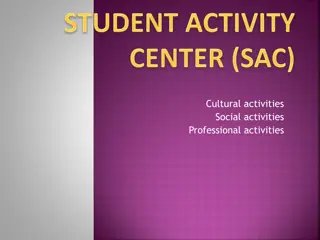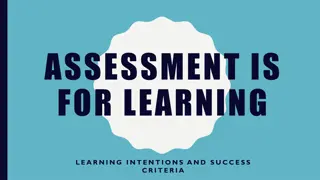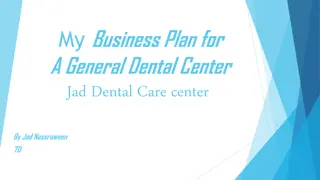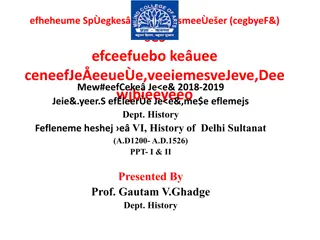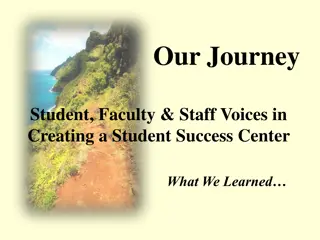Student as a center of learning
Education has evolved, with students now taking a central role in learning. Teachers focus on guiding rather than lecturing, fostering problem-solving skills and real-life readiness. Online education emphasizes project-based tasks, responsibility, and flexibility. This shift contrasts with ancient education that was limited and class-based. Quotes from Socrates and Einstein highlight the importance of experience, imagination, and continuous learning. Successful teaching requires understanding students and innovative approaches, moving away from rote learning. Education serves as a community, with the goal of nurturing independent, active learning in students.
Download Presentation

Please find below an Image/Link to download the presentation.
The content on the website is provided AS IS for your information and personal use only. It may not be sold, licensed, or shared on other websites without obtaining consent from the author.If you encounter any issues during the download, it is possible that the publisher has removed the file from their server.
You are allowed to download the files provided on this website for personal or commercial use, subject to the condition that they are used lawfully. All files are the property of their respective owners.
The content on the website is provided AS IS for your information and personal use only. It may not be sold, licensed, or shared on other websites without obtaining consent from the author.
E N D
Presentation Transcript
Student as a center of learning Goranka Stani School of Aplied Arts and Design, Osijek, Osijek,Croatia goranka.stanic@gmail.com
Abstract Abstract The new age, still ongoing in a pandemic The role of students and the role of teachers changed . Not all information is useful teacher at the center to lead a monologue in the form of a lecture. Knowledge is the ability to solve problems and more complex problems and the readiness for real life. The opportunity in the new ONLINE way of education should direct the student to the responsibility of performing project tasks and the flexibility
ancient education was not organized or made possible for everyone. Some knowledge was non-functional for those periods. If a person did not belong to the higher classes, he settled his needs and knowledge with basic physical work and survival knowledge.
Quotes from Socrates Experience is the best school, and the only tuition is costly. I can t teach anyone anything, and I can only make them think. Quotes by Albert Einstein Logic will take you from A to B. Imagination will take you wherever you want. The true sign of intelligence is not knowledge but imagination. Imagination is more important than knowledge. At some point in life, reading distracts the mind too much from its creative possibilities. Anyone who reads too much and uses too little of their own brain is in danger of indulging in a lazy habit of thinking. One who has never made a mistake has never tried anything new. Education must be such that what it offers is taken as a precious gift, not a repulsive obligation. The mind is like a parachute - it only works if it is open. A true scientist will never believe in some opinions just because they are written in certain books. Also, he will never believe that the results of his research are final.
For successful results the teacher must have the ability to understand students find ways to more successfully approach the issue of teaching and materials, instead of focusing on referring and repeating a bunch of facts A school is a form of community life Education makes a common mistake
Student as a center of learning Student as a center of learning Independent active learning What I hear, I forget. What I see, I remember. What I do, I understand. Chinese proverb
Student Student- -centered classroom centered classroom The timing and development of society as a whole, independent of the state, leads to changes in students' and teachers' relationships. In addition to the student's obligations, the student is also protected by their rights
Active learning The definition of active learning includes elements that enable students to listen, talk, read, write and reflect on the contents, ideas and topics of the teaching process with understanding. Research is an indispensable way of conducting active learning. The research includes data collection, selection of sources, conducting surveys, questionnaires, organization of collected data and quality assessment
Active learning Active learning encourage students to work individually, or in pairs, in small groups, exploring and defining the task and time needed to complete it. Upgrading by collecting information from various sources, independent notes, summaries, highlighting the main idea. Active learning is involvement in work that achieves mutual reflection of teachers and students
The classroom becomes a space without rules where the basis for the development of events is students' interest, curiosity, and activity.. Students are not bored they are allowed to use everything and choose the content they are interested in and plan to deal with in their future. It is necessary to cope with new challenges, and it is essential to find a way to solve a problem that can no longer be inherited from generation to generation.
Advantages of independent active learning Advantages of independent active learning programs that connect all subjects are directed respects the individual's personality organizational skills way of learning allows to choose and develop a strategy. The evaluation of such teaching is also focused on the student's self- criticism, self-assessment.
Distance learning Distance learning Distance learning is not a modern phenomenon. The emergence of the first distance teaching began in 1728 when Caleb Phillips, a teacher in Bonston, offered students short classes through weekly mail lectures. After 1984 Isaac Pitman, a British teacher taught shorthand through correspondence courses. Among many other examples, distance learning has adapted to existing developments in society and technology.
ONLINE teaching ONLINE teaching . The Internet environment requires both student and teacher to take active roles. Independent learning has advantages, but it can also be problematic. The student can immerse himself too much in educated applications, indulge in solving tests in the form of quizzes and games and lose interest in teaching in the classroom. teaching with a teacher. We live in a time when it is questionable whether technology and distance learning will take over the model of classical education. Synchronous learning from multiple sources simultaneously involves all students in the educational process in the form of video conferencing, web conferencing, educational television, Internet radio, satellite live streaming, live video streaming, telephone, mobile devices and applications.
The student, together with the teacher, shapes the course - offers a unique approach - provides content in modern user interfaces - offers content that is practical and effective - integrates multimedia - assesses meaningful learning - affects the sense of community - collects feedback - encourages flexibility - maintains continuity
Conclusion The use of educational applications in education can be an advantage and a disadvantage. Technology does not disappear. Schools must learn to integrate the use of educational applications into their classrooms effectively. There must be no oversaturation at the school. Teachers must receive additional training on how to use and follow the latest technologies. Students must use technology responsibly, respect usage restrictions, and respect privacy. Schools must have reliable safeguards in their network and prevent students from accessing inappropriate and non-educational content. Students dictate the time and pace of learning by asynchronous learning, which is more flexible than synchronous learning.Technology cannot escape. Children of the millennium were born in the age of the internet. Technology has become mainstream and assimilated into learning. In this time, with exponential changes and achievements, the student becomes an active participant in the acquisition of knowledge, often knowing better some content than the teachers themselves.
References References . E. Jensen, Super-nastava (Nastavne strategije za kvalitetnu kolu i uspje no u enje), Educa, Zagreb, 2003. Milan Matijevi , Diana Radovanovi , Nastava usmjerena na u enika, kolske novine, Zagreb, 2011. Author, F., Author, S., Author, T.: Book title. 2nd edn. Publisher, Location (1999). Milan Matijevi Alternativne kole: didakti ke i pedago ke koncepcije, Tipex, Zagreb, 2001. CARDS Project, Labour Market Reform and Workforce Development, 2008.(31.03.2021) http://www.waldorfska-skola.com/(31.03.2021) http://www.hrmdrustvo.hr/montessori_pedagogija.html(21.03.2021)
